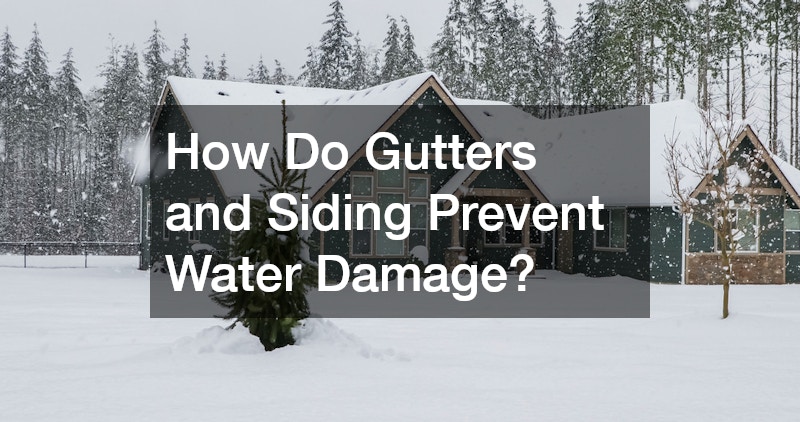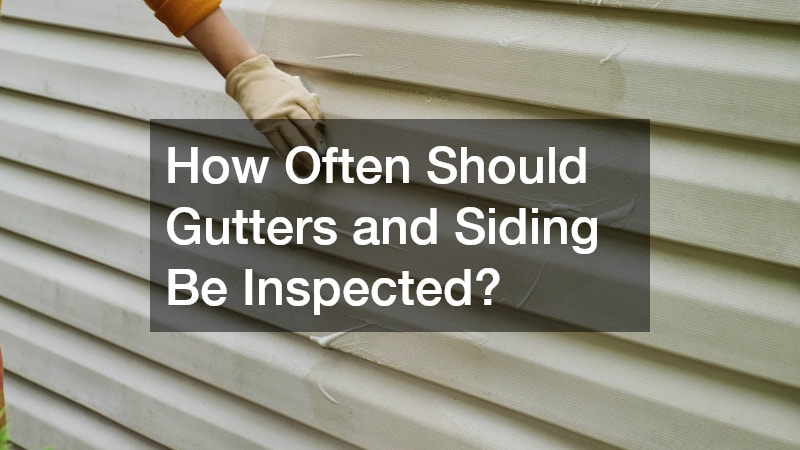Maintaining a dry and secure home requires more than just a high-quality roof. It involves the seamless cooperation of your roofing system, gutters, and siding. These three elements form the outermost shield protecting your property from moisture intrusion, environmental wear, and water damage. When properly installed and maintained, they keep your home structurally sound, visually appealing, and energy efficient. This article explores how each part contributes to your home’s water defense and why strategic planning and regular upkeep are essential.
How Do Gutters and Siding Prevent Water Damage?

Impact on Foundation Health
Gutters play a vital role in diverting rainwater away from your foundation. Without them, water can collect around the base of your home, leading to erosion, cracks, or even basement flooding. A reliable gutter system, often installed by a local gutter company, protects against these problems by ensuring water is channeled several feet from the house. At the same time, siding acts as a barrier to prevent runoff from soaking into the exterior walls, adding another layer of protection against foundational weakening.
Protection Against Mold and Mildew
Moisture trapped inside your home’s walls creates the perfect breeding ground for mold and mildew. A quality siding install prevents water penetration, especially in areas prone to driving rain or snow. Gutters minimize splashback and reduce the chance of water finding its way behind the siding. Working together, these systems decrease indoor humidity and reduce the risk of respiratory issues caused by mold spores. Homeowners in humid climates benefit even more from properly sealed siding and well-maintained gutters.
Role in Preventing Leaks
Leaks often begin on the outside of a house. Poor drainage, damaged gutters, or cracked siding can allow water to seep in through joints, seams, or window frames. A robust exterior envelope that includes intact siding and functioning gutters helps manage water flow and directs it away from vulnerable points. This is especially important for homes with older doors and windows, which may be more prone to leaks unless properly sealed and maintained.
Maintaining Structural Integrity
Water is incredibly destructive to wood framing, insulation, and drywall. Gutters that overflow can cause rot in soffits, fascia, and roof decking. Meanwhile, neglected siding can allow moisture into the wall assembly, weakening studs and insulation. Many professional roofers recommend inspecting the siding and gutter systems during routine roof inspections to catch potential weaknesses early. When properly integrated, these components ensure your home’s structure stays strong and dry for years.
Preventing Discoloration and Staining
Overflowing gutters and stained siding are common signs of water mismanagement. Streaks, mold patches, and algae growth diminish curb appeal and can reduce property value. Clean gutters, paired with stain-resistant siding, prevent the buildup of grime and discoloration. Many siding contractors suggest seasonal Pressure Washing to keep exterior surfaces looking fresh and to remove organic debris that could cause permanent stains or surface damage.
What Are the Best Materials for Gutters and Siding?
Aluminum Versus Vinyl Durability
Aluminum gutters and vinyl siding are both popular choices due to their durability and affordability. Aluminum resists rust and denting, making it ideal for long-term performance, especially in areas with heavy rainfall. Vinyl siding is favored for its ease of installation and resistance to pests. However, over time, extreme temperatures can cause cracking or warping. Choosing a quality product and hiring an experienced siding contractor can reduce the risk of early failure for either material.
Cost-Effectiveness of Materials
The right material depends on both budget and long-term expectations. Vinyl siding offers a lower initial investment and requires minimal upkeep, while aluminum gutters have a slightly higher upfront cost but may last longer with fewer repairs. Homeowners aiming for energy efficiency may consider insulated siding, which can also lower utility bills. For those seeking to balance budget and performance, combining vinyl siding with aluminum gutters offers a strong, cost-effective exterior solution.
Environmental Considerations
Eco-conscious homeowners may prefer recyclable materials like aluminum or fiber cement siding. Recycled aluminum is commonly used by modern roofers and gutter installers due to its sustainability. Vinyl, although not as environmentally friendly during production, is making strides with newer, greener formulations. Choosing materials with a longer life span helps reduce overall environmental impact by minimizing the need for frequent replacement.
Maintenance Requirements
Maintenance requirements vary between materials. Vinyl siding is relatively hands-off but should be checked regularly for cracks or warping. Aluminum may require repainting over time but is easy to clean and resistant to insect damage. Gutters must be cleaned regularly to ensure optimal flow and reduce clogging. Partnering with a local gutter company can take the hassle out of seasonal maintenance, especially when combined with a roofing or siding maintenance plan.
Aesthetic Values and Curb Appeal
The visual harmony between your shingle roof, gutters, and siding defines the curb appeal of your home. Matching gutter color to your roof trim or siding creates a polished appearance. Many homeowners also coordinate their doors and windows with the rest of the exterior to maintain consistency in design. Modern siding materials come in a variety of textures and colors, allowing you to personalize your home’s look without compromising on durability or weather resistance.
How Often Should Gutters and Siding Be Inspected?

Seasonal Inspection Frequency
At a minimum, homeowners should inspect their gutters and siding twice a year—once in the spring and again in the fall. Seasonal changes can loosen fasteners, warp materials, and introduce debris into the gutter system. These semi-annual checks help identify minor issues before they evolve into major repairs.
Identifying Signs of Wear
Peeling paint, cracked siding panels, sagging gutters, or rust stains are early warning signs of deterioration. If you notice water pooling near the foundation or visible gaps between siding panels, it’s time to investigate further. Discoloration on interior walls may also indicate that water is breaching your home’s exterior layers.
Professional Versus DIY Inspections
While many homeowners feel comfortable performing visual inspections, hiring a professional siding contractor or local gutter company can yield more thorough results. These experts know where to look for hidden issues and can recommend preventative measures. Roofers often inspect gutters and siding during roof evaluations, which adds another layer of protection and peace of mind.
Checklist for Gutter Inspections
When inspecting gutters, look for blockages, leaks at the seams, and signs of sagging or pulling away from the house. Check downspouts for obstructions and ensure water is exiting far from the foundation. Tighten any loose brackets and examine fascia boards for water damage.
Checklist for Siding Inspections
Check for warping, cracking, or holes in the siding. Pay close attention to the areas around windows and doors, as these are prone to leaks. Look for mold growth, rot, or soft spots that indicate moisture intrusion. Review caulking around seams and joints, especially near roof lines or gutters.
Why Is Gutter Cleaning Important?
Avoiding Clog-Related Damages
Clogged gutters are one of the most common and preventable sources of water damage. Leaves, twigs, and debris create dams that cause water to overflow, spilling down siding and eroding landscaping. These blockages can even lead to ice dams in colder months, which cause severe damage to both gutters and roofing materials.
Tools and Techniques for Cleaning
Cleaning gutters typically involves removing debris by hand or with a scoop, followed by flushing with a garden hose. For high or hard-to-reach gutters, professional tools such as extendable wands and vacuum systems may be required. Safety should always be a priority, especially when working on ladders near a shingle roof.
When to Call a Professional Cleaner
If your home is two stories or higher, or if the gutters are heavily clogged, hiring a professional is the safest choice. A local gutter company has the equipment and experience to perform the job quickly and thoroughly. They may also offer add-on services like Pressure Washing the siding or inspecting for damage.
Seasonal Cleaning Schedules
Spring and fall are the ideal times to clean your gutters. In spring, clean out any debris left from winter storms. In the fall, remove falling leaves and prepare for potential snow accumulation. Scheduling regular cleanings prevents overflow and preserves the longevity of your entire drainage system.
Long-Term Benefits of Regular Cleaning
Routine gutter cleaning protects your siding, foundation, and landscaping. It also prevents the premature aging of your gutter system and avoids costly repairs. A clean, well-functioning gutter system enhances overall home value and supports the longevity of your siding and roofing components.
What Are Common Problems With Gutters and Siding?
Identification of Common Gutter Problems
Frequent issues include sagging sections, detached downspouts, leaking seams, and rust spots. These problems reduce the gutter’s ability to channel water effectively, leading to overflow or pooling at the foundation. Regular cleaning and maintenance reduce the occurrence of these issues.
Identification of Common Siding Problems
Siding can crack, fade, or warp over time. Improper installation, particularly near doors and windows, may lead to moisture intrusion. Some types of siding are also susceptible to insect damage or mold growth, especially if not sealed properly. Repeated exposure to high-pressure water during improper Pressure Washing can also weaken siding panels.
Solutions to Frequent Issues
Minor cracks or gaps in siding can often be sealed with caulk or replaced individually. Leaky gutters may require resealing or replacing damaged sections. For larger problems, hiring a qualified siding contractor or local gutter company ensures a long-term fix.
Prevention Measures
Installing gutter guards can reduce clogging. Sealing joints and caulking around windows helps preserve siding. Ensuring your roof, gutters, and siding are all inspected annually allows early detection of problems and more affordable repairs. Many professionals also recommend scheduling periodic Pressure Washing to keep surfaces clean and functional.
Repair Versus Replacement Decisions
Small issues can often be repaired, but widespread damage or age-related deterioration may necessitate replacement. When siding or gutters reach the end of their lifespan, it’s often more cost-effective to replace them entirely. A siding contractor can assess your current materials and advise whether repair or replacement is the better investment.
How Do You Install Gutters in Relation to Your Siding?
Tools Required for Installation
Gutter installation requires brackets, sealants, screws, levels, and downspout extensions. Safety gear is also essential, especially for homes with multi-story exteriors or steep roof pitches.
Installation Steps Outline
Installation begins by measuring the length of the roof edge and marking the correct slope for water flow. Brackets are attached to the fascia board, followed by the gutters themselves. Downspouts are then added at low points to ensure efficient drainage. Special care must be taken not to interfere with the siding during this process.
Impact of Gutter Placement on Siding
Improper gutter placement can allow water to cascade down the siding, leading to rot, stains, and mold growth. Correct positioning ensures that runoff is directed into the gutters, not over the siding surface. The interaction between roof edge, gutters, and siding must be carefully managed during installation.
Ensuring Water Is Directed Properly
Downspouts should lead water at least three feet away from the foundation. Extensions or splash blocks help redirect water and prevent erosion. Proper grading of the landscape around the home further supports this drainage. Keeping water away from unwanted areas reduces the likelihood of needing expensive window replacement
Installation Errors to Avoid
Common mistakes include inadequate slope, poor alignment, or failing to seal joints. These errors reduce gutter efficiency and can lead to damage across all exterior systems. Always consult professionals—many roofers and gutter specialists offer bundled installation services to ensure compatibility with your roof and siding.
How Do Gutters and Downspouts Work Together?

Roles of Gutters and Downspouts
Gutters collect water from the roof, while downspouts transport it safely to the ground. Without both components functioning in harmony, your home is vulnerable to moisture damage. A properly designed system ensures that water doesn’t accumulate on the roof, against the siding, or around the foundation.
Optimal Positioning for Water Flow
Downspouts should be placed at the lowest slope points of the gutter system. The number and location of downspouts depend on your roof’s size and pitch. Proper spacing ensures water flows quickly and doesn’t overflow during heavy rain.
Preventing Soil Erosion
Downspouts that discharge too close to the foundation can erode soil and weaken structural supports. Extensions or underground drainage pipes prevent erosion and protect landscaping. Many local gutter companies offer evaluation and customization to suit your yard’s layout.
Enhancing System Longevity
Clean, correctly installed gutters and downspouts last longer and perform better. Installing gutter guards, using rust-resistant materials, and scheduling regular cleanings can add years to your system’s lifespan and reduce repair costs.
Solutions to Downspout Overflow
Overflow usually results from clogs or insufficient capacity. Larger downspouts or additional drainage lines can relieve pressure. For homes with frequent heavy rainfall, upgrading to oversized gutters may also be beneficial.
What Are the Signs of Gutter and Siding Failure?
Visual Indicators of Wear
Peeling paint, rust, sagging gutters, or cracked siding are all signs that exterior systems are failing. Pay attention to water stains, mold growth, and damp spots inside your home.
Impact of Climate on Materials
Materials expand and contract with temperature changes. In cold climates, freezing and thawing can damage gutters. In tropical areas, UV rays can degrade vinyl siding over time. Selecting the right materials for your environment is key to longevity.
Detecting Water Damage Early
Discoloration near windows, bubbling paint, or musty odors may signal hidden leaks. Regular inspection and early action can prevent extensive and costly repairs later.
Consequences of Neglected Repairs
Delaying repairs often leads to structural damage, mold growth, or pest infestations. Timely maintenance saves money and preserves home value.
Seeking Expert Evaluations
If you suspect gutter or siding failure, contact a professional for an evaluation. Whether it’s a siding contractor, roofer, or local gutter company, expert input ensures you make informed decisions about repairs or upgrades.
How Do Different Climates Affect Gutters and Siding?
Impact of Extreme Weather Conditions
Heavy snow, wind, and rainfall test the durability of gutters and siding. Choosing materials rated for your region’s weather conditions ensures long-term performance.
Preparation for Seasonal Changes
Before winter or storm season, clean gutters, seal siding gaps, and inspect rooflines. Preventive maintenance reduces the chance of water intrusion during extreme weather.
Adaptation for Tropical Climates
In humid areas, mold-resistant siding and rust-proof gutters are essential. Frequent Pressure Washing may also be needed to combat algae buildup.
Adaptation for Cold Climates
Freeze-resistant gutter materials and insulated siding help protect homes in cold regions. Roofers often recommend heated gutter cables to prevent ice dams.
Material Choice for Varying Climates
Fiber cement, metal, or engineered wood siding may outperform vinyl in harsh environments. For gutters, aluminum is widely regarded as the most climate-resilient material.
How Does Proper Roof Maintenance Play Into Gutter and Siding Efficiency?

Ways Roof Affects Gutter Lifespan
Damaged shingles or poor roof drainage increase the strain on gutters. A clean, well-maintained shingle roof reduces the risk of gutter clogging and overflow.
Roof Inspection Techniques
Look for missing shingles, soft spots, or granule buildup in gutters. Many roofers offer comprehensive inspections that include gutter and siding evaluations.
Impact of Roof Debris on Siding
Leaves, branches, and granules from an aging shingle roof can clog gutters and stain siding. Regular cleaning and trimming of overhanging trees help keep siding clean and gutters clear.
Coordinating Maintenance of All Systems
Roof, gutters, and siding should be inspected together. Coordinated care helps identify water management issues early and ensures a unified defense against moisture.
Long-Term Benefits of Holistic Maintenance
A proactive maintenance strategy preserves curb appeal, prevents costly damage, and enhances your home’s resale value. By caring for your roof, gutters, and siding as one integrated system, you protect your investment for the long haul.
Final Thoughts
The combined performance of your roof, gutters, and siding is critical in protecting your home from water damage and environmental wear. These components must work in unison, using quality materials and regular maintenance to stay effective. From selecting the right siding contractor to coordinating inspections with your local gutter company, staying ahead of potential issues ensures a dry, healthy, and beautiful home for years to come.


